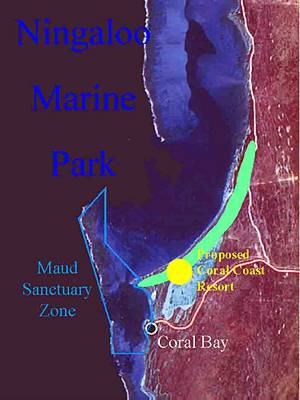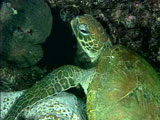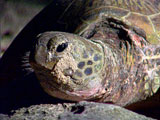
Turtles
There are four turtle species found in the vicinity of the proposed development
at Maud's Landing. These are the loggerhead, green, hawkesbill and flatback
(Natator depressus) turtles. Of these, the loggerhead turtle is listed
as a schedule 1 species under the Environment Protection and Biodiversity Conservation
Act 1999 (Commonwealth). Under the same act, green turtles are listed as a priority
4 species. Bateman Bay, the area directly in front of the proposed development,
is a known breeding ground for populations of loggerhead and hawkesbill turtles.
These populations are completely dependent on the Pt. Maud beach for their survival,
with approximately 80 nests being laid each year (P. Mack, pers. comm).
 |
Endangered loggerhead, and green and hawksbill turtles nest on the beach that the resort will dissect. One of this years nests sits within 200m of the proposed construction. |
It has been found that the density of turtles in Ningaloo Marine Park exceeds the highest densities of turtles that have ever been recorded in the Great Barrier Reef Marine Park area (Preen et al, 1997). This high density has partially been attributed to the particularly clear waters of the area (Preen et al, 1997).
THREATS

As turtles are marine reptiles that come to shore only to lay their eggs, they are very sensitive to changes to the coastal environment. One of the main concerns regarding the proposed development is the resulting likelihood of a decrease in turtle nesting activity due to increased beach disturbance. Studies of turtle nesting sites all over the world have shown that coastal development is the greatest threat to nesting activity, with nesting decreasing with increasing beach disturbance (Arianoutsou, 1988). An increased amount of traffic on beaches (people and/or vehicle) can also indirectly decrease turtle nesting by compacting the sand, making digging very difficult (Arianoutsou, 1988). It is also possible that people trampling over nests can induce the premature emergence of hatchlings, making them much more vulnerable to predation (Arianoutsou, 1988). As the proposed development at Maud's Landing is expected to increase the number of people in the area by at least 2000, the above threats are very real.
A number of buildings in the proposed resort are two and three storey apartments, indicating that lights from these will be visible from the beach. In addition, any lighting placed around the development will change the light levels on the Bateman Bay beach. When turtle hatchlings emerge from their nests, which is generally at night, they move towards the area of most light (Arianoutsou, 1988). At night this is the ocean. However, when lights from coastal developments are visible from the beach, the hatchlings become disorientated and move towards these lights instead of the ocean (Arianoutsou, 1988). The hatchlings eventually turn around and move towards the ocean, but in the process have wasted much energy and greatly increased their chance of being taken by predators. Lights visible from the beach can also affect nesting levels as they discourage the females from coming onto the beach to nest (Arianoutsou, 1988).

The boat numbers in Bateman Bay are expected to increase from their current maximum of 75 to a new maximum of 240. This would increase the likelihood of turtles being hurt or killed due to collisions with boats. Particularly dangerous are collisions with propellers. More people on the water will also lead to more litter in the ocean, with the ingestion of plastic bags by turtles a particular concern. There is also the issue of turtles becoming entangled in discarded fishing line and hooks.
Noise levels in the Maud's Landing area will increase during and after construction of the development in comparison with current levels. The effect of noise on turtles is as yet unknown, but is it possible that unnatural sounds may interfere with natural ones that act as behavioural signals, with unknown consequences (Arianoutsou, 1988).
It is apparent that the proposed development will be likely to have a negative
effect on the turtles reliant on the Bateman Bay beach for their long-term survival.
As these turtles are recognised as being under threat, ensuring their conservation
and continued breeding success should be a priority.
REFERENCES
Arianoutsou, M. 1988, 'Assessing the impacts of human activities on nesting of loggerhead sea-turtles (Caretta caretta L.) on Zakynthos Island, Western Greece', Environmental Conservation, vol. 15, No. 4, pp. 327 - 334.
Preen, A.R., Marsh, H., Lawler, I.R., Prince, R.I.T. and Shepherd, R. 1997, 'Distribution and abundance of dugongs, turtles, dolphins and other megafauna in Shark Bay, Ningaloo Reef and Exmouth Gulf, Western Australia', Wildlife Research, vol. 24, pp. 185 - 208.